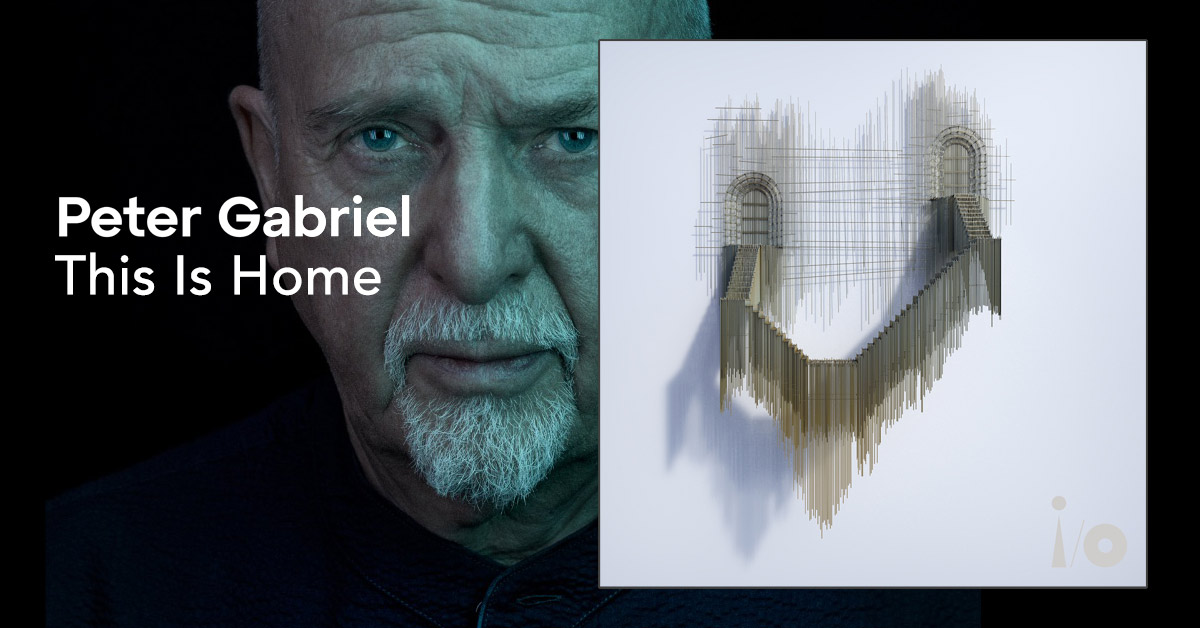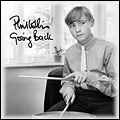


We are nearing the end - with This Is Home, the third to last track for the album (and probably also on it) is released.
Apparently, initial ideas were started together with the American DJ and producer Skrillex. But the development then went in a different direction and Skrillex is not to be heard on the finished track.
Gabriel calls what finally emerged a love song - it is about relationships. Otherwise, he doesn't say much about the lyrics of the song. Maybe he doesn't have to. - Nevertheless, something is added now.
It is once again a rather lyric-heavy song: four verses, the chorus repeated, no less than two intermediate parts and a (but amost wordless) final part. Despite this abundance, This Is Home is actually simple and clear in its narrative.
It is a lyrical piece about finding peace and togetherness. The first verse describes large and small perceptions that one can have in familiar surroundings. In addition, reference is made to a counterpart who is important in all of this.
The chorus simply says: "I know this is home - home is where I need to be" and then even more clearly "I know you are my home". The counterpart addressed here can still be a place as well as a loved one person.
And there are further declarations of being one - even while struggling through the hustle and bustle of everyday life. The first interlude even says "And we float on love like a river through the night". While the second interlude states somewhat less prosaically, "When we make it hard (...) then the love creeps through, from deep in me and you."
Finally, it is reiterated that even if all issues cannot be resolved, home is "where I am holding you - there's nowhere else I'm going".
There is no big story developing in This Is Home - only deep happiness and inner contentment is spread out.
All lyrics of the album can be found on Peter Gabriel's website here.

This time it is a sculpture that accompanies an i/o song. The artist comes from Spain, his name is David Moreno and his work is entitled: Conexión De Catedral II (English: Cathedral Connection).
Interesting: Originally, a sculpture was made especially for the song, which was also shown in the tour book. It showed a house with arched connections from the entrance to the roof. But Gabriel, looking through Moreno's work again, thought that the current object with two doors and a staircase between them fit much better.
Moreno works with wood, plastic, steel - and especially piano strings. From these, he creates objects that look like sketches by an architect, representing buildings or groups of houses, but step out of the wall into the third dimension.
They seem strangely fleeting, strangely weightless. And at the same time there is something homely - something close.
David Moreno was born in Barcelona in 1978. He is a trained architect, but soon devoted himself to artistic work and since 2006 he has been exhibiting in galleries and museums worldwide. He lives and works between Rotterdam and Barcelona.
More about all artworks and the artists behind them is gathered here.
Apparently, Gabriel did not focus on "opulence" for the musical expression here, otherwise he would probably have chosen the Bright-Side Mix for the first release for this light, friendly song. Tchad Blake, as always, presents a rather edgy, cleared version.
The 17-second intro sets a lot: Organ, rumbling bass - densely mixed with muffled drums - handclaps. It's earthy and not very electronic - it would have fit perfectly on US. Gabriel says that the first inspiration for the track was Tamla Motown Rhythm groups, which "we're trying to recreate in a modern way".
In any case, the intro immediately reveals the musical foundation on which the whole track moves. Everything radiates a certain nonchalance. But here in the Dark-Side Mix, the slight reggae associations that came up at the concerts don't come into play - the sound is rather dull, the groove striding.
Gabriel emphasises that for the lead vocals he chose the stylistic device of singing the first part low, then the second high. It results in strong tension without strained pressure.
Backing vocals join in for the chorus, though the voices lack a concise character - it's not even entirely clear whether it's men or women singing here (it's apparently just Ríoghnach Connolly). Gabriel's singing is also very much in the centre - even when he is supported, it seems soloistic.
After one and a half minutes, the first interlude is reached. Gabriel describes it as "atmospheric and dreamy". You can hear calm string lines and the Swedish male choir Orphei Drängar, which adds a partial hum or buzz. There is indeed something shimmering and alien about the passage.
Separated by a verse and a chorus, the second interlude comes a good minute later, which is "catchy and poppy" for Gabriel. Here, the orchestra's interjections are musically driving and lively, in keeping with the lyrics.
After a final verse-chorus pairing, This Is Home turns into the final section with Gabriel's vocal improvisations placed further back in space. It all ends with a final exclamation, with a subtle twinkle still providing a prolonged fade-out.
The most prominent feature of the piece is that it passes through with a certain equanimity. There are no great climaxes or even excesses. The arrangement is also rather sparse. Accompanying elements that clearly stand out (such as a special instrument) do not occur. Everything remains restrained and open. And once again, Tchad Blake emphasises the mids and lows. He hardly places anything in higher pitches.
Another track on i/o that is carried by the fact that a band laid the musical foundation here in sessions. It seems alive and real. When was the last time Gabriel had that?
A special addition is, of course, the Swedish male choir Orphei Drängar, but it is only heard in the first interlude. It takes up considerably more space in the credits.
Besides Manu Katché on drums, almost the entire Realworld recording crew participates on percussion: Oli Middleton, Katie May and Oli Jacobs. The latter does even more: he is involved in rhythm programming and on the synthesizer (besides Gabriel himself), as well as on additional guitar.
Brian Eno joins in again - although apparently only on the first interlude.
And finally, Ríoghnach Connolly does the backing vocals again.
For the October New Moon, we are offered a version of This Is Home that is more playful than the Dark-Side Mix. Spike has clearly made more elements audible - so many that the impression arises that everything that was left out by Tchad Blake should have been included here.
But the song still retains its composure - indeed, the playfulness perhaps even makes it more light-hearted.
Directly with the intro, one of the most striking additions stands out: The basic beat is emphasised by the handclaps, which were only heard occasionally in the Dark-Side Mix. Here they run through the whole track and only disappear in the two intermediate parts. They immediately bring a new, folky atmosphere.
Smaller additions are also perceptible here and there. Keyboard fills or pads, which - mostly quietly - bring additional colours. Fine percussion details are also occasionally inserted - or suddenly even a discreet drum machine for the first intermediate part.
Actually, there is almost a constant change in the musical means. Much remains in motion and varies. However, these additions do not always stand in the foreground in a striking way, but usually only act as part of the whole - so they do not completely break through the basic structure.
This remains the same - bass, drums, interspersed guitar, backing vocals to the choruses. The appearance of the Swedish choir is also essentially unchanged, just like that of the strings a little later. But everything seems more integrated and less exposed here than in the Dark-Side Mix. Just united into one of Spike's "soundscapes", which are not always easy to pervade.
Perhaps there is so much going on over the course of this version that the Bright-Side Mix seems a little unfocused all in all.
Similar to the Bright-Side Mix, the drums, percussion and handclaps in the Dolby Atmos version are particularly differentiated. Every single beat on the snare drum can be heard crystal clear and the song seems very rhythmic from the beginning. The individual elements of the rhythm section are divided differently in the sound panorama.
When listening with Apple AirPods Pro, especially toms, snare drum and bass seem to stay in position when you turn your head, while handclaps, tambourine, guitar and the introductory keyboard riff follow your head movements. The lead vocal also has its fixed position in the mix.
After the first chorus, there are sporadic keyboard interjections that buzz discreetly in the background at different positions. In the course of the song, it is noticeable that guitar and bass are also heard very clearly and at the same time with the necessary pressure for the song.
The first intermediate part sounds very spherical. Extensive 3D effects are not used here in favour of the very organic overall sound. After a short verse part, the second intermediate part follows, in which the orchestra also comes into its own.
Towards the end of the song, variations can be heard again in comparison to the previous sequence, which are mainly produced by percussion and keyboard. Especially in the outro, spherical sounds are used again, which are distributed in different positions in the sound panorama.
Overall, it is noticeable that the In-Side Mix tastefully follows the style and the arrangement of the song and does not rely unnecessarily on effects.
The alternative version of This Is Home was released with a significant delay in November, in which everything is already focussed on And Still.
It is once again a "Post-Band Version" and once again shows how much foundation the i/o studio band lays for the individual songs. But it also becomes clear again how significant Gabriel's further additions are.
This version is very pure, very unadulterated. The overall sound is much more percussive than in the two main mixes, swinging and bouncing at least as much. Overall, however, the version is still quite muffled. The vitalising additions are not yet there - the light is still missing.
After a brief introduction of guitar, keyboards, bass and above all percussion, the handclaps, which are already familiar from the Bright-Side Mix, take centre stage at 0:19. It's still not quite clear who they actually come from - Oli Middleton, who is credited here solely for percussion? From the whole band? They actually sound too organic to be sampled (or they would be really good samples). In any case, the clapping runs through the entire song and ensures a never-ending forward momentum.
The vocal track still seems to be a temporary one. Gabriel starts a little late, which seems a little botched. Overall, his singing is more restrained, less collected. The change between low and high verses, for example, is noticeably less dynamic.
The whole song then remains in a continuous flow. Even through the two intermediate parts. In the first one, the only significant change is the use of choir voices, which are sampled and make a rather synthetic impression. They must be taken as a placeholder for the still absent male choir, even if they do not have its lower register. The second intermediate section brings no changes at all - apart from the harmony and melody.
The final passage also runs through. The vocal improvisation is missing, there is no intensification in the arrangement, the song simply progresses until it ends with a subtle cymbal sound.
The absence of all the small additions, especially the synthesiser and guitar, as well as the orchestra, brings out the percussive elements, which also appear more delicate. This creates moving and playful moments. On the other hand, the fact that this version runs through so evenly makes an almost more relaxed impression than the two main mixes.
Incidentally, the running time is the same as the main mixes, but the 19 seconds of lead time mentioned above have been added at the beginning, while the final passage is about 10 seconds shorter and the fade-out is also quite brief.



New Album featuring Motown Classics. Release date: September 13th, 2010 (Europe), September 28th (NA)


Remastered, contains rare "Silver Song" with Phil Collins on Vocals.
Review available